|
International Journal of Academic
Research in Education and Review
Vol. 2(1), pp. 1–16,
January,
2014
ISSN: 2360-7866
DOI: 10.14662/IJARER2013.010
Full
Length Research Paper
Effects
of inquiry-based teaching approach on Secondary School Students’
achievement and motivation in Physics in Nyeri County, Kenya
Njoroge, G.N., Prof.
Changeiywo, J.M, Prof. Ndirangu, M.
Department of
Curriculum, Instruction and Educational Management, Egerton University,
P.O. BOX 536-20115, Egerton, Kenya. Corresponding author's Email:
ngnjoro@yahoo.com
Accepted 14
January 2014
The overall
students’ performance in physics at the Kenya Certificate of
Secondary Examination (KCSE) has been poor coupled with very low
student enrollment. The preferred mode of delivery by physics
teachers in Kenyan secondary schools is the expository teaching
approach. This approach is dominant despite growing evidence that it
is not effective in inculcating the content knowledge, conceptual
knowledge and science process skills that are part of quality
physics teaching. Available literature shows that Inquiry-Based
Teaching (IBT) approach is capable of promoting these attributes
among students. However, there is little documentary evidence on the
effects of Inquiry-Based Teaching (IBT) approach on secondary school
students’ achievement in physics in Kenyan secondary schools. This
study aimed at finding out the effects of IBT approach on students’
achievement in physics in Nyeri, County. The study adopted a
Quasi-Experimental Research Design. Solomon-Four Non-equivalent
Groups Design was involved. Stratified random sampling technique was
used to select four boys’ and four girls’ county secondary schools
in Nyeri, County. The four schools in each category were assigned to
treatment and control groups by simple random sampling technique.
Each group had one boys’ and one girls’ county secondary school.
Each school provided one form two class for the study and a total of
370 students were involved. Students in all the groups were taught
the same physics content but the experimental groups were taught
using IBT approach while the control groups were taught through
Regular Teaching Methods (RTM) such as lecture method and teacher
demonstrations. The experimental group I and the control group II
were pre-tested prior to the implementation of the IBT treatment.
After four weeks, all the four groups were post-tested using the
Students’ Physics Achievement Test (SPAT). The instrument had been
validated by five experts in education and pilot tested before use
to estimate its reliability. The reliability coefficient using K-R21
was 0.87. The acceptable threshold for reliability coefficient is
0.7 and above. The instruments were scored and data was analyzed
using t-test, one way ANOVA and ANCOVA at a significance level of
coefficient alpha (α) equal to 0.05. The findings of the study
showed that Inquiry-Based Teaching (IBT) approach resulted into
higher students’ scores in achievement in physics. The study
recommends that Teacher training institutions, Kenya Institute of
Curriculum Development (KICD) and physics teachers should enact IBT
approach as the preferred physics teaching approach in Kenyan
secondary schools.
Key words: Expository Teaching Approach; Inquiry-Based
Teaching Approach; Students’ Achievement in Physics
Science educators and in particular physics teachers in secondary
schools need to change their teaching approaches to make them more
effective and relevant to a much larger proportion of the student
population than in the past (International Bureau of Education, 2000;
Wieman and Perkins, 2005). This is as a result of rapid scientific and
technological innovations over the past several decades. Many of the
problems confronting society currently, such as global warming,
terrorism, genetic modification, global market competition, energy and
population crises, ethical issues involving biotechnology among other
critical issues, require physics knowledge, if they are to be dealt with
rationally (Safeer and Keenan, 2005; UNESCO, 2010). Modern
knowledge-based economies are so heavily dependent on technology. Thus
having a better understanding of physics and technology, and better
technical problem-solving skills will enable people to meet the
challenges and demands of the work place (Effandi and Zanaton, 2006;
Porter, Ketels and Delgado, 2007). Furthermore, a modern knowledge-based
economy will flourish only if it has a workforce with high level of
technical understanding and skills (Wieman and Perkins, 2005).
Technological advancement has brought the Information Technology (IT)
revolution. It is evident that any society that will be left out of this
revolution risks total isolation from the global family (SMASSE, 2004).
Consequently there are economic and social benefits both to individuals
who study physics and to countries whose citizens include many
individuals with extensive scientific and technical knowledge. Thus, a
country requires scientifically and technically literate citizenry to
advance her national development agenda. Hence, the need to structure
secondary school physics teaching approaches in line with the twenty
first century skills (Pacific Policy Research Center, 2010). The twenty
first century skills include creativity and innovativeness, critical
thinking and problem solving, communication and collaboration,
information, media and technology, life and career skills among others.
Secondary school education is a critical level in any educational
system. As a transitional level to higher education, it is important for
economic development of a nation, socialisation and empowerment of the
youth who are faced with massive levels of unemployment (United Nations
Education Scientific and Cultural Organisation [UNESCO], 2005) Nations
all over the world lay a lot of emphasis on secondary school education.
The structure and content of the secondary school curriculum of a nation
is constantly revised with the aim of making it relevant and sensitive
to the country’s educational goals and aspirations. In Kenya, numerous
curriculum reforms aimed at making education responsive to the national
development goals have been made. The 8-4-4 education system was
launched in January 1985 and was designed to provide eight years of
primary, four years of secondary and four years of university education
(Ministry of Higher Education Science and Technology [MOHEST], 2004).
The 8-4-4 education system aimed at introducing vocational and technical
education so as to meet the demands of the economy, fostering national
development, providing a relevant curriculum for the Kenyan youth,
addressing the economic and regional disparities and providing a
practical oriented curriculum (MOHEST, 2004). Thus, the system
introduced a broad based curriculum at every level. Science subjects
were initially classified into chemistry, physics, biology, biological
sciences and physical sciences. However, the science curriculum has
undergone several structural and fundamental changes and currently pure
sciences are offered in all secondary schools in Kenya (Kenya Institute
of Curriculum Development [KICD], 2002).
According to the Kenya National Examinations Council (KNEC), physics is
clustered with biology and chemistry. However, students must select and
pursue at least two science subjects at Form Three and Four (KNEC,
2005). Majority of the students opt for a combination of chemistry and
biology due to subject clustering system which does not favour physics.
Also, most of the students consider the concepts involved in the study
of physics to be too abstract and difficult to understand. This may
account for the current low students’ achievement, motivation and
enrolment in the subject. Performance in physics has been low and many
students shun the subject as indicated in Table 1.
Table 1 show that performance in physics has been poor and the subject
is unpopular amongst secondary school students compared to chemistry and
biology. Several studies have investigated the causes of the appalling
state of physics performance and low student enrolment. These causes
were identified as low students’ motivation to learn physics, poor
teaching approaches used by physics teachers, poor content mastery by
the physics teachers, teachers’ use of language in classrooms, perceived
difficulty of the subject, inadequate instructional materials and
inadequate supervision from the Ministry of Education Science and
Technology among other factors (Strengthening of Mathematics and
Sciences in Secondary Education [SMASSE], 1998; Etkina, 2005; Ndirangu,
2000; Kiboss, 2002: Oyoo, 2009). In response to the low students’
achievement and motivation to learn physics SMASSE project organized
National and District In-Service Training (INSET) for teachers
emphasizing the need to adopt ASEI/PDSI teaching approach. The ASEI/PDSI
approach, which means Activity Student Experiments and Improvisation and
Plan Do See and Improve respectively, advocated a shift from
teacher-centred to student-centred physics teaching approaches (SMASSE,
1998).
The Kenya Certificate of Secondary Examination (KCSE) report for 2006 on
students’ performance advised teachers to give plenty of exercises,
guide students into the insight of the concepts taught and to cover the
syllabus within the allocated time (KNEC, 2007). Despite these
interventions and changes in the physics curriculum, KCSE physics
results as indicated in Table 1 reflect a percentage performance of
below 42%. Available data also indicate a gender disparity in
performance in physics in Kenyan secondary schools as shown on Table 2.
Table 2 shows that the performance of girls is lower than that of boys
in physics in Kenyan secondary schools. Thus, there is need to address
the prevailing disparity in physics performance with respect to gender.
In Nyeri County, students’ achievement and enrolment in physics has been
low as is the case nationally as indicated in Table 3.
Table 3 shows that students’ achievement and percentage of students
taking physics in Nyeri County has been low. The poor performance in
physics may be attributed to in appropriate teaching methods and
approaches used by physics teachers, poor distribution and utilisation
of school resources, low student motivation to learn physics and
incompetence in science processes and skills amongst secondary schools
physics students among other factors (SMASSE, 1998). Considering that
physics is a requirement for many vocational and technical courses in
universities and other tertiary institutions, there is need to enhance
students’ achievement and motivation to learn the subject. The
performance in physics is below the expectations that Kenya would
require to actualize her goal of industrialisation and becoming a middle
level income country by the year 2030 (Republic of Kenya, 2007). Hence,
the poor performance reflects the challenge Kenya faces in having
adequate number of qualified students enrolling in scientific and
technological disciplines in educational and training institutions in
the country.
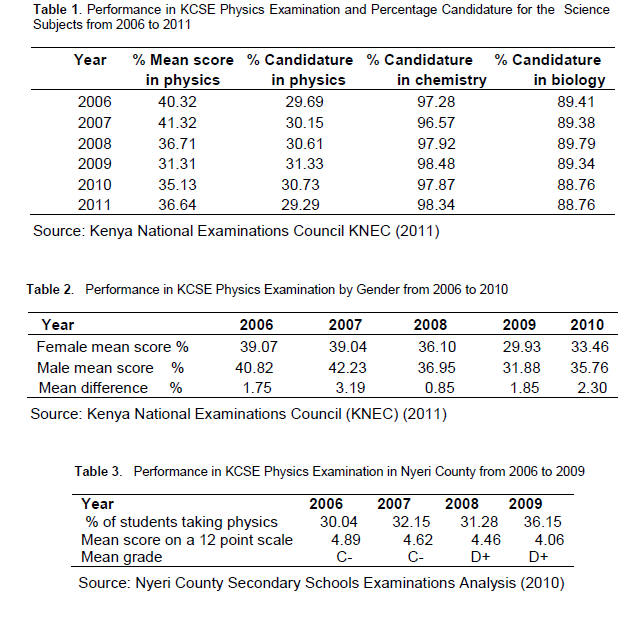
Secondary school education in Kenya aims
at ensuring that students graduating at that level have adequate
scientific knowledge while meeting the needs of those who terminate
their studies after secondary school and those who proceed to
tertiary institutions (Education Info Centre, 2006). Physics like
any other science subject is compulsory in the secondary school
curriculum in form one and two but majority of the students do not
select physics in Form Three. Majority of the students consider the
concepts involved as too abstract to understand and the content
taught too difficult to learn. Available literature shows that
majority of the students in Kenyan secondary schools have inadequate
knowledge and understanding of physics concepts and principles (SMASSE,
2001). In effect, the topic Magnetic Effect of an Electric Current
has constantly been difficult to learn by students or to teach by
teachers. According to a SMASSE baseline survey 58% and 62% of the
teachers and students interviewed indicated the topic as difficult
to teach by teachers and to learn by students respectively (SMASSE,
2005). This is consistent with the KNEC reports which show that
candidates have been performing dismally on questions in this topic
(KNEC, 2006).
Considering that concepts and principles involved in the study of
Magnetic Effect of an Electric Current are a prerequisite for the
study of Electromagnetic Induction among other topics in the
secondary school physics course. Therefore, there is need to equip
students with a strong background in this topic. The principles,
concepts and skills involved in the study of Magnetic Effect of an
Electric Current are also widely used in the design and construction
of electric motors, the television, loudspeakers, moving coil meters
and electric bells (Muriithi and Ringeera, 2002). Approaches used in
teaching physics have been identified as one of the factors
contributing to the low student achievement in physics among other
factors (American Association of Physics Teachers, [AAPT], 2009).
Thus, a teaching approach that a teacher adopts may motivate
students to learn and therefore affect their achievement in physics.
Inquiry-Based Teaching (IBT) approach is used to describe teaching
strategies that are driven by scientific inquiry (Kahn and O’Rourke,
2005). The approach is deeply rooted in constructivism teaching
practices. It is student-centred rather than teacher-centred and
offers students opportunities to be actively involved in
experimenting, questioning and investigating. The approach has been
considered as being capable of promoting motivation among secondary
schools students since it creates interest in the process of
acquiring scientific knowledge and skills (Gibson and Chase, 2002).
Research findings indicate that Inquiry-Based Teaching (IBT) may be
very effective in enhancing student achievement and motivation to
learn science as well as development of scientific process skills (Sola
and Ojo, 2007; Khan and Iqbal, 2011). Students’ academic motivation
is their tendency to find academic activities meaningful and
worthwhile and to try to derive the intended academic benefits from
the teaching and learning process (Dowson and Mclnerney, 2001). High
academic motivation has consistently been linked to increased levels
of students’ academic achievement (Kushman, Sieber and Harold,
2001). Thus, the development of students’ motivation in Kenyan
secondary schools is a valuable objective for physics teachers
because of its inherent importance in enhancing students’
achievement in the subject.
The study of Magnetic Effect of an Electric Current in the secondary
school physics course is meant to enable the students, perform and
describe experiments to determine the direction of the magnetic
field round a current-carrying conductor, to determine magnetic
field patterns on a straight conductors and the solenoid. The topic
also aims at enabling the students to apply Fleming’s Left-Hand
Rule, to explain the working of simple electric motor, electric
bell, loudspeaker, telephone receiver and magnetic relays among
other applications. The concepts, skills and principles acquired in
this topic are essential in the study of other topics such as
electromagnetic induction, cathode rays and cathode ray
oscilloscope, magnetism, mains electricity, electronics,
radioactivity and x-rays in the secondary school physics curriculum
(Kenya Institute of Curriculum Development, 2002). The above topics
are highly examinable at KCSE level. Table 4 below shows the number
of questions, the total mark and the percentage contribution of the
topics in the KNEC physics examination paper 2 for the past five
years.
Table 4 shows that the topic Magnetic Effect of an Electric Current
and other closely related topics in the KNEC physics examination
paper 2 for the years 2008 to 2012 contributed about twenty percent
of the total mark. Given that the percentage performance in physics
is below 42%, there is need to enhance the learning of the topic
Magnetic Effect of an Electric Current in the secondary school
physics course in Kenya and in Nyeri County in particular.
Furthermore magnetic fields are widely used throughout modern
technology, particularly in electrical engineering and
electro-mechanics. This study aimed at finding out the effect of
Inquiry-Based Teaching (IBT) approach on students’ achievement in
learning Magnetic Effect of an Electric Current in Nyeri County
secondary schools.
Purpose of the Study
This study was designed to investigate the effect of Inquiry-Based
Teaching (IBT) approach on secondary school students’ achievement in
the learning of physics based on the topic Magnetic Effect of an
Electric Current.
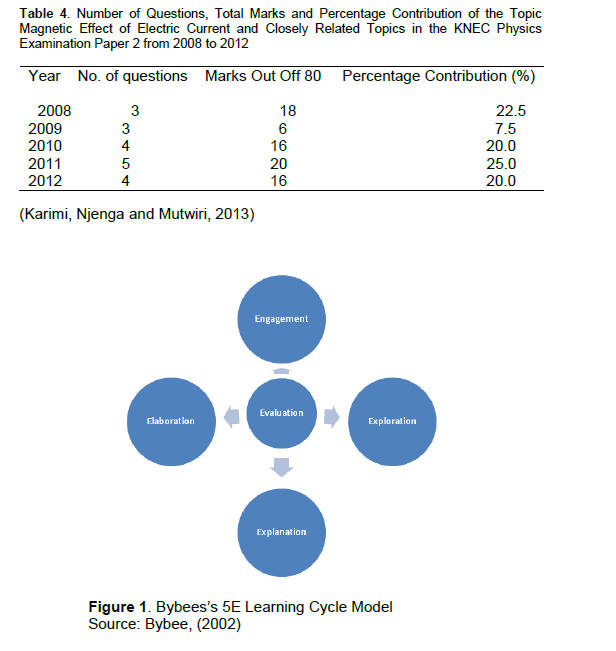
Objectives of the Study
The objective of this study was to determine whether there is a
difference in students’ achievement in the learning of Magnetic
Effect of an Electric Current of students exposed to IBT approach
and those taught using the Regular Teaching Methods, RTM.
Hypotheses of the Study
To achieve the objectives of this study, the following null
hypothesis was tested at a significance level of alpha equal to
0.05:
Ho1: There is no statistically significant difference in students’
achievement in learning Magnetic Effect of an Electric Current
between students’ taught using IBT approach and those taught using
the Regular Teaching Methods, RTM.
Theoretical Framework
The theoretical framework that guided this study was based on
Bybee’s 5E learning cycle model which is an Inquiry-Based Teaching (IBT)
approach model (Llewellyn, 2005). The 5 E learning cycle model
sequences learning experiences so that students have the opportunity
to construct their understanding of a concept during the teaching
and learning process (Bybee, 2002). The model leads students through
five phases of learning that are easily described using words that
begin with the letter E: Engagement, Exploration, Explanation,
Elaboration and Evaluation. Bybee’s 5E learning cycle model is
represented in Figure 1.
Figure 1 shows Bybee’s 5E learning cycle
model. In the engagement phase the teacher captures students’
interest and makes them curious about the topic and concepts to be
learnt. This phase provides an opportunity for the teacher to find
out what students already know or think they know about the topic
and concepts to be developed (Bybee, 2002). In the exploration phase
students interact with materials and ideas through classroom and
small group discussions (Llewellyn, 2005). This helps the students
to acquire a common set of experiences so that they can compare
results and ideas with their classmates. In the explanation phase
students are provided an opportunity to connect their prior
experiences with current learning and to make conceptual sense of
the main ideas. This phase also provides the opportunity for the
introduction of formal language, scientific terms and content
information that might make students’ prior experiences easier to
describe. In the elaboration phase students’ are provided with the
opportunity to apply introduced concepts to new experiences
(Llewellyn, 2005). This phase helps students to make conceptual
connections between new and prior experiences, connect ideas and
deepen their understanding of concepts and processes. In the
evaluation phase that is centrally placed in the model and takes
place virtually in every phase of the 5E learning cycle model
provides a summative assessment of what students know (Bybee, 2002).
Jones’ Music Model of Academic Motivation was also applied in this
study. The Music Model of Academic Motivation consists of
psychological components that have been derived from research and
considered to be critical to student engagement during content
presentation (Jones, 2009). This model integrates aspects of
existing motivation constructs that are important for secondary
school physics teachers to consider in classroom settings. IBT
approach combined with Bybee’s 5E Learning Cycle model may provide
students with a wider range of learning experiences within the
concept of Magnetic Effect of an Electric Current. This may lead to
deeper conceptual understanding and skills development which may
enhance students’ motivation to learn and students’ achievement in
the topic Magnetic Effect of an Electric Current.
Conceptual Framework
The conceptual framework of this study is represented
diagrammatically in Figure 2.
The relationships between variables of the study are shown on Figure
2. In an ideal situation, the teaching approach would affect the
students’ achievement and motivation to learn Physics. In practical
situations the students’ achievement and motivation to learn Physics
will be influenced by various factors which include, teacher
training, teachers’ epistemological views on teaching, learning and
teaching resources as shown in Figure 2. These are extraneous
variables which need to be controlled. The study involved trained
physics teachers to control the teacher variable because teacher
training determines how effectively a teacher will enact the
teaching approach. Also the involved teachers taught the same
content from a common syllabus to all students for the same
university entrance examination. The students’ age and hence their
class determines what they are taught. Form two students who are
approximately of the same age were involved in the study. To control
for teachers’ epistemological views on teaching the involved
teachers were inducted through a training program and the researcher
closely monitored the implementation of the Inquiry-Based Teaching (IBT)
Approach intervention to the treatment groups.
In this study students’ achievement in physics was measured using
the students score in SPAT. The Students’ Physics Achievement Test
(SPAT) was constructed based on the topic Magnetic Effect of an
Electric Current in the secondary school physics course. This is
because the concepts involved are considered too abstract to
understand and the content too difficult. The concepts, principles
and skills involved in the topic are essential in the study of other
topics such as electromagnetic induction, magnetism, mains
electricity, cathode rays and cathode ray oscilloscope, current
electricity, x-rays and electronics. These topics are highly
examined in the KNEC physics paper two as indicated on Table 4
METHODOLOGY
Research Design
The study was Quasi-experimental involving Solomon Four
Non-Equivalent Control Group design. This is because there was
non-random assignment of students to the groups. Secondary school
classes exist as intact groups and school authorities do not
normally allow the classes to be dismantled and reconstituted for
research purposes (Shadish, Cook and Campbell, 2002).
Quasi-experimental researches are widely used in the evaluation of
teaching interventions because it is not practical to justify
assigning students to experimental and control groups by random
assignment (Randolph, 2008). Quasi-experimental research offers the
benefit of comparison between groups because of the naturally
occurring treatment groups (Cohen, Manion and Morrison, 2007). The
experimental group was exposed to the treatment and the control
group received no treatment. The performance of the two groups was
then compared after data collection to determine whether there was
any treatment effect. Solomon Four Non-Equivalent Control Group
Design was involved since it controls the major threats to internal
validity except those due to interaction, and history, maturity and
instrumentation (Sekaran, 2006). The Solomon Four Non-Equivalent
Group Control Design involves setting up two experimental groups and
two control groups for the study. The effect of treatment is then
calculated in a number of different ways to the extent that the
researcher comes up with almost the same results in each of the
calculations. Hence the effect is attributed to the treatment, thus
establishing a cause and effect relationship. This increases the
internal validity of the results. In this study, schools were
assigned to the four groups by purposive sampling technique. Figure
3 shows the Solomon Four Non-equivalent Group Control Design.
Figure 3 shows the research design that was used for the study.
Where O1 and O3 were pre-test; O2, O4, O5, O6 were the post-test; X
was the treatment where students were taught using Inquiry-Based
Teaching (IBT) approach. The broken lines separating the parallel
rows indicate that assignment of students to the experimental and
control groups was not by random assignment.
i) Group I was the experimental group which received the pre-test,
treatment X and the post-test.
ii) Group II was the control group that received a pre-test,
followed by the control condition and then the post-test. This group
helped to see whether or not history, maturation, testing,
regression or mortality was a threat to internal validity.
iii) Group III received the treatment X and post-test but did not
receive the pre-test. This group helped to establish whether or not
testing effects were a threat to internal validity. The difference
if any between O2 and O5 were attributed to testing effects.
However, if O2 and O5 were equal then the internal validity was not
affected by testing effects.
iv) Group IV received the post-test. This group helped to establish
whether or not the changes in the post-test scores of the
experimental group were a function of the combined effects of
history and maturation by comparing O6 with O1 and O3. If all the
scores were equal, history and maturation was not a threat to
internal validity.
Schools in the experimental groups I and III were taught using IBT
approach while those in the control groups II and IV were taught
using the Regular Teaching Methods (RTM).
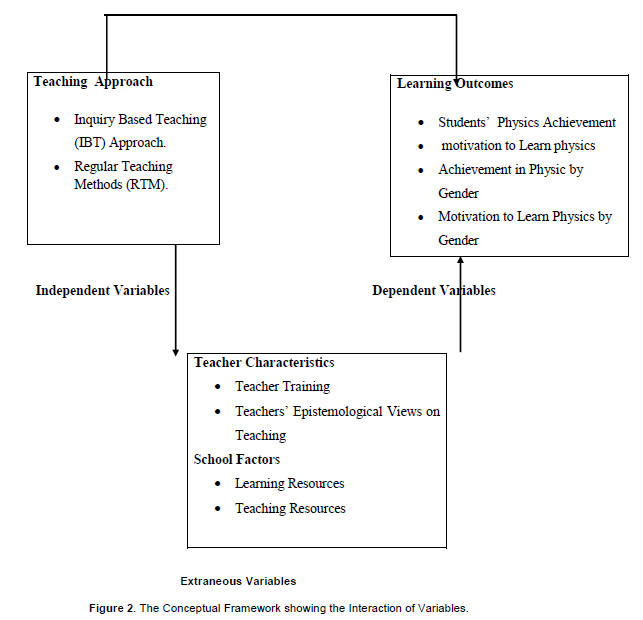
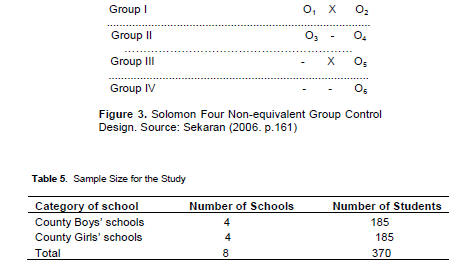
Sampling Procedures
The unit of sampling was the secondary school rather than individual
students because secondary schools operate as intact groups
(Randolph, 2008). Stratified random sampling technique was used to
select four county boys’ and four county girls’ secondary schools.
Stratified random sampling technique was used in order to obtain a
representative sample of the whole population with respect to gender
(Cohen et al., 2007). The assignment of one form two stream per
school selected to either experimental or control group was done by
simple random sampling technique. Since majority of the county
secondary schools have more than one stream per form, simple random
sampling technique was used to select one stream for the study.
Table 5
Sample Size
Table 6 shows that four county boys’ secondary schools and four
county girls’ secondary schools were involved in the study. The
sample size for the study was 370 students comprising of 185 boys
and 185 girls in eight intact classes. Fraenkel and Wallen (2000)
recommend at least 30 subjects per group. Thus, the sample size was
considered adequate for this study.
Instrumentation
The Students’ Physics Achievement Test (SPAT) was used to assess
students’ achievement in learning Magnetic Effect of an Electric
Current in the secondary school physics course. The Students’
Physics Achievement Test (SPAT) was constructed from the Kenya
National Examinations Council (KNEC) past examination papers which
were modified to make them suitable for this study. The test items
were constructed based on the topic Magnetic Effect of an Electric
Current and were used as pre-test and post-test to allow for
comparison between pre-test and post-test results. The SPAT
consisted of 16 structured questions with a maximum score of 39
marks testing on conceptual knowledge and application of the
concepts and principles learnt. The SPAT was pilot tested using a
school in a County that was not included in the actual study but had
similar characteristics as the sampled schools to avoid
contamination.
Validity is defined as the accuracy and meaningfulness of inferences
which are based on the research results (Cohen et al., 2007). In
other words validity is the degree to which results obtained from
the analysis of the data actually represent the phenomena under
study. There are three major types of validity: face validity,
content validity, and construct validity. The SPAT was validated by
four research experts from the department of CI&EM of Egerton
University, Njoro, for content, construct and face validity. Also
the content validity of the questions was reviewed by five
experienced secondary school physics teachers who are physics
examiners with KNEC. The reliability coefficient of SPAT was
estimated using Kuder-Richardson formula 21 (Gronlund, 1990). The
K-R21 formula is suitable in cases where the items can be scored
dichotomously. Kuder-Richardson estimates of reliability tests
whether all the items measure the same quality or characteristics.
The reliability coefficient of the SPAT using K-R21 formula was
0.87. According to Fraenkel and Wallen (2000), a reliability
coefficient of alpha value 0.7 and above is considered suitable to
make possible group predictions that are sufficiently accurate.
The Development and use of Inquiry-Based Teaching (IBT)
Instructional Materials
Physics as a science subject is activity based and the suggested
method for teaching it which is Inquiry-Based Teaching (IBT)
approach is resource-based (Franzer, Okebukola and Jegede, 1992).
The instructional materials and the content used in the class
instruction were developed in line with the revised KICD (2002)
physics syllabus. A guiding manual was developed for the teachers
involved in the implementation of IBT approach and was used
throughout the treatment period. The teachers of the experimental
groups were trained on how to use the manual by the researcher. The
teachers were trained on how to enact IBT approach on a different
topic other than Magnetic Effect of an Electric Current for one week
to make them conversant with Inquiry-Based Teaching (IBT) approach.
After the training period the pre-test was administered to groups I
and II. The treatment period was four weeks as recommended in the
KICD (2002) physics syllabus. After the treatment period a post-test
was administered to all the groups.
Data Collection
The researcher obtained permission from Graduate School, Egerton
University through a letter which was used to secure a research
permit from the National Commission for Science, Technology and
Innovation (NACOSTI). The researcher sought clearance from the Nyeri
County Director of Education. The principals and physics teachers of
the participating schools were informed of their schools’ inclusion
in the study and their co-operation requested. Before the treatment,
pre-test was administered to the experimental Group I and the
Control Group II. The students in the experimental Group I and Group
III were taught the topic Magnetic Effect of an Electric Current
using IBT approach while those in the Control Group II and Group IV
were taught using RTM. After four weeks the post-test was
administered to all the groups.
Data Analysis
The SPAT was scored and quantitative data generated. Data was
analyzed using one-way ANOVA, analysis of covariance (ANCOVA) and a
t-test with the aid of Statistical Packages for Social Science (SPSS)
computer program. Analysis of variance (ANOVA) was used to determine
if the four groups differed significantly among themselves on
experimental variables. Analysis of covariance (ANCOVA) was used to
cater for the initial differences
among the groups. A t-test was used to test differences between two
means because of its superior quality in detecting differences
between twomeans (Coolican, 1994, Gall, Borg and Gall, 1996). All
tests of significance were tested at a significance level of 0.05.
RESULTS
Solomon Four Non-equivalent Control Group Design was used in this
study. This enabled the researcher to have two groups sit for the
pre-test. Group 1 and 2 sat for pre-test SPAT. The researchers were
able to assess the entry behaviour of the students (Gall et al.,
1996). Table 7 shows the independent samples t-test for SPAT.
The results of the pre-test SPAT, Table 6 shows that the mean scores
of Group 1 and 2 were not statistically significantly different
since t (181) = 0.47, p > 0.05. This meant that the groups used in
the study exhibited comparable characteristics. The pre-test was
administered to the experimental group 1 and the control group 2 to
determine whether the groups were similar. The groups were therefore
regarded suitable for the study
Effects of Inquiry-Based Teaching Approach on Students
Achievement in Magnetic Effect of an Electric Current
To determine the effect of Inquiry-Based Teaching Approach on
students’ achievement in Magnetic Effect of an Electric Current, the
analysis of Post-test SPAT mean scores was carried out. Hypothesis
one, Ho1 of the study stated that there is no statistically
significant difference in students’ achievement in the learning of
Magnetic Effect of an Electric Current between students exposed to
Inquiry-Based Teaching (IBT) Approach and those that were exposed to
Regular Teaching Methods (RTM). The groups had been given both the
pre-test and the post-test. Thus the testing effects across all the
groups had been nullified and the post-tests of each of the
experimental groups could be compared with that of the control
groups to detect the effects of treatment. The mean scores of the
four groups are shown on Table 7.
The results on Table 7 show that the mean scores of the experimental
groups 1 and 3 were higher than those of the control groups 2 and 4.
The results of the mean scores on SPAT are represented in a bar
graph in Figure 4.
The graph shows clearly that the schools in the experimental groups
1 and 3 performed better in the Post-test than the schools in the
control groups 2 and 4. To establish whether the mean scores were
statistically significantly different, analysis of one–way variance
(ANOVA) was carried out and the results are shown on Table 8.
The results on Table 8 shows that at 0.05 alpha level, the SPAT mean
scores of the experimental and control groups were statistically
significant F (3,366) = 30.34, p < 0.05). Also F calculated > F
tables meaning that the difference between the SPAT mean scores of
the experimental and control groups were statistically significant.
ANOVA is a statistical procedure that compares the amount of
between-groups variance in individual scores with the amount of
within-groups variance (Gall, Gall and Borg, 2007). The ratio of
between-groups variance to within-groups variance was sufficiently
high, indicating that there was a higher difference between the
groups in their scores than there was within each group. After
establishing that there was a significant difference between the
means, further tests were carried out on the various combinations of
means to find out where the difference occurred. The tests were
conducted using Scheffe’s procedure at 0.05, alpha level. The Post
Hoc is a statistical procedure used to determine in which of the
multiple groups the difference lie (Sekaran, 2006). The results of
Post Hoc comparisons are shown on Table 9.
The results on Table 9 indicate that the
pairs of SPAT mean scores of groups 1 and 2, groups 1 and 4, groups
2 and 3 and groups 3 and 4 were statistically significantly
different at 0.05 alpha level. However, the mean scores of group 1
and 3 and groups 2 and 4 were not statistically significantly
different. The main threat to the internal validity of
non-equivalent control group experiments is the possibility that
group differences on the post-test may be due to initial or
pre-existing group differences rather than to treatment effect (Gall
et al., 1996). Since this study involved non-equivalent control
groups, it was necessary to confirm the results by performing
analysis of covariance (ANCOVA) using students’ Kenya Certificate of
Primary Education (KCPE) marks as the covariate. This was to reduce
the effects of initial group differences statistically by making
compensating adjustments to the post-test mean scores of the groups
involved. Table 10 shows the adjusted SPAT Post-test mean scores.
The results were represented on a bar graph to show the adjustments
as shown in Figure 5.
Figure 5 shows that the adjusted SPAT post-test mean score for
ANCOVA with KCPE as covariate was high in the experimental groups 1
and 3 compared to the control groups 2 and 4. The results of the
adjusted SPAT Post-test mean scores enabled an analysis of
covariance to be done and the results are shown in Table 11.
The results on Table 12 shows that there was still a statistically
significant difference since F (3,164) = 12.26, p <0.05. F
calculated > F tables meaning that the difference between the SPAT
mean scores of the experimental and control groups were
statistically significant. To establish where the differences
occurred, a Post Hoc pair-wise comparisons based on ANCOVA was
carried out and the results shown on Table 12.
The Least Significant Difference (LSD) test results on Table 12
indicate that there was a statistically significant difference at
0.05, alpha level between groups 1 and 2, groups 1 and 4, groups 2
and 3 and groups 3 and 4. However, there was no statistically
significant difference at 0.05, alpha level between groups 1 and 3
and groups 2 and 4. This confirms the ANOVA results to be correct.
This therefore means that the teaching approach used to teach the
experimental groups had significant effect on students’ achievement
as compared to the approach used on the control groups. A comparison
of the SPAT Pre-test and Post-test means scores was carried out and
the results are shown on Table 13.
Table 13 shows that students in the experimental group 1 had a
higher mean gain than those in the control group 2. This meant that
Inquiry-Based Teaching (IBT) Approach resulted in higher students’
achievement in the learning of Magnetic Effect of an Electric
Current than the Regular Teaching Method (RTM). This confirms the
results of the ANOVA and ANCOVA. Therefore hypothesis one, Ho1 which
stated that there is no statistically significant difference in
students’ achievement in learning Magnetic Effect of an Electric
Current between students taught using Inquiry-Based Teaching (IBT)
Approach and those taught using the Regular Teaching Methods (RTM)
is rejected.
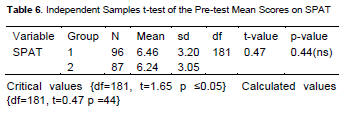

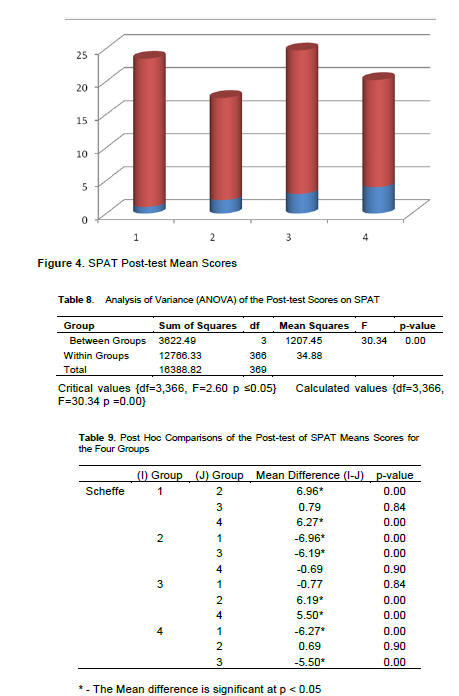
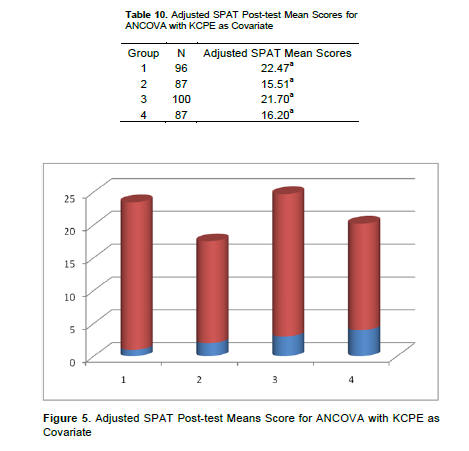
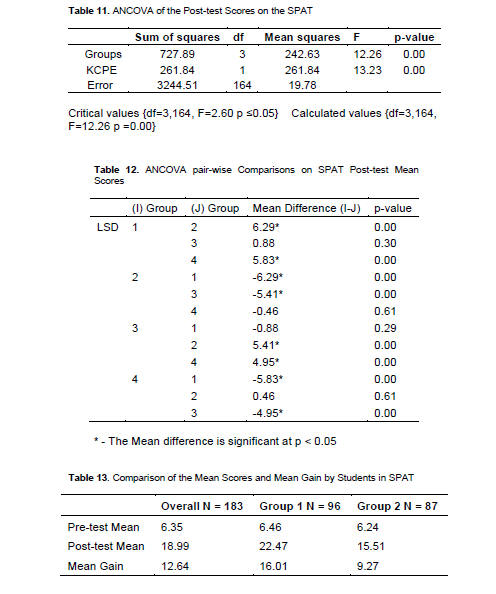
DISCUSSIONS
An examination of Table 8 reveals that the difference between the
experimental group 1 and the control group 2 is statistically
significant F(1,366)=30.34, p<0.05. This would, therefore, suggest
that Inquiry-Based Teaching (IBT) Approach enhanced the achievement
of students who were in the experimental group compared to those in
the control group. The results of this study indicate that the
students taught using Inquiry-Based Teaching (IBT) Approach achieved
significantly higher mean scores in the SPAT than those taught
through Regular Teaching Methods (RTM). This implies that
Inquiry-Based Teaching (IBT) Approach is more effective in enhancing
students’ achievement than Regular Teaching Methods (RTM). A study
conducted by Vanosdall, Klentschy, Hedges and Weisbaum (2007)
involving fifth grade students in California State showed that the
use of Inquiry-Based Teaching Approach (IBT) approach led to higher
achievement in learning of mixtures and solutions in chemistry than
did those taught using the regular teaching methods.
Khan and Iqbal (2011) studied the effectiveness of Inquiry-Based
Teaching Approach (IBT) on the development of scientific processes
and skills among nineth grade secondary schools students of biology.
The findings of the study affirmed the impact of Inquiry-Based
Teaching Approach (IBT) on the students’ learning outcomes in that
the mean gains of the students in the treatment groups were
significantly higher than that of the students in the control
groups. Also, the results indicated that the mean difference between
the experimental and the control groups were statistically
significant in favour of the treatment group. Sola and Ojo (2007)
studied the effect of inquiry models of teaching. The results of
this study showed that inquiry models of teaching were very
effective in enhancing student achievement and skill development.
They reported that student achievement scores and analytical skills
were either raised or greatly enhanced. Marx, Blumenfeld, Krajcik,
Fishman, Soloway, Geier and Revital (2004) in their study involving
sixth, seventh and eighth grade physics students over a three year
period found out that students who took part in the inquiry
curriculum made statistically significant gains in achievement. The
researchers concluded that an inquiry approach led to higher gains
in knowledge of the content, understanding of the process, and
overall achievement. Amaral, Leslie and Klentschy (2002) in their
study involving fourth and sixth grade students in Latino school
district in southern California studied the effect of inquiry-based
approach in science and mathematics. The results of the study
indicated that inquiry-based approach led to greater proficiency in
science and mathematics. The researchers concluded that the hands-on
activities allow learners to construct context, to develop positive
attitudes toward learning and to engage in authentic conversation
with other students.
CONCLUSIONS
Inquiry-Based Teaching Approach (IBT) produced a significant
difference in students’ achievement in the learning of Magnetic
Effect of an Electric Current in the secondary school Physics course
between students taught through it and those taught through Regular
Teaching Methods (RTM). The post-test SPAT mean scores of
Experimental Groups 1 and 3 was 22.46 and 21.70 respectively, while
that of Control Groups 2 and 4 was 15.51 and 16.70 respectively.
Comparison of the mean scores and mean gain by students in SPAT
indicated students in the experimental groups gained more than those
in the control groups.
Implications of the Study
Students taught through the Inquiry-Based teaching approach attained
higher scores in the SPAT than those taught through the regular
teaching methods. Therefore, education authorities in Kenya should
encourage physics teachers to use this approach and teacher training
institutions to make it part of their teacher training curriculum
content.
Recommendations of the Study
The findings of this study suggest that the use of Inquiry-Based
Teaching (IBT) Approach can be an effective approach in enhancing
students’ achievement in learning Magnetic Effect of an Electric
Current. Based on these findings, this study proposes the following
recommendations:
i) Teacher training should be designed to produce teachers capable
of planning and implementing Inquiry-Based Teaching approach.
ii) Teachers in schools should be given training in planning and
implementing Inquiry Based Teaching approach through in-service
courses. This may be an effective teaching approach in providing
suitable learning conditions for students of diverse learning styles
and academic abilities that is common in most classroom settings.
iii) Students taught through Inquiry-Based Teaching approach
performed better and had higher mean scores than those taught
through the Regular Teaching methods that Inquiry-Based Teaching (IBT)
approach would be suitable for teaching both boys and girls.
Therefore, education authorities in Kenya should encourage physics
teachers to use this approach.
Suggestions for Further Research
The findings of the study indicate that Inquiry-Based Teaching (IBT)
approach is effective in enhancing students’ achievement and
motivation in learning magnetic effect of an electric current in the
secondary school physics course. However, there are areas that
warrant further investigation.
These include the following;
i) A comparative study involving single sex and co-educational
schools setting to establish whether the findings apply to the two
categories of schools since they are the most prevalent in Kenya.
ii) Studies involving the impact of Inquiry-Based Teaching approach
on the motivation of teachers. Since Inquiry-Based Teaching approach
is quite demanding on both the teachers and students may be an in
depth study of the impact on teachers would be helpful.
iii) Studies involving larger sample sizes in terms of participating
schools, students and teachers to confirm whether or not the present
findings hold.
iv) A long-term study preferably on another relatively longer topic
investigating more variables to find out how such variables interact
with Inquiry-Based Teaching approach to bring meaningful learning.
v) Studies involving more topics in physics or involving other
science subjects since the science subjects are similar in teaching
context approach.
REFERENCES
Amaral O, Leslie G, Klentschy M (2002). Helping English Learners
Increase Achievement through Inquiry-Based Science Instruction.
Bilingual Res. J. 26 (2): 225-234.
American Association of Physics Teachers (AAPT) (2009). The Role,
Education, Qualifications and Professional Development of Secondary
School Physics Teacher. One Physics Ellipse College Park, MD.
Bybee RW (2002). Scientific inquiry, student learning, and the
science curriculum: Learning science and the science of learning.
Arlington, VA: NSTA Press.
Cohen L, Manion L, Morrison K (2007). Research methods in education.
New York, NY: Routledge press.
Coolican H (1994). Research methods in psychology. London: Hodder
and Sloughlon Education.
Dowson M, McInerney DM (2001). Psychological parameters of students’
social and work avoidance goals: A qualitative investigation. J.
Educ.Psychol., 93(1):35-42.
Education Info Center (2006). Kenya High Commission, Ottawa Canada.
Retrieved August2, 2011, from
http://www.kenyahighcommission.ca/primary.htm
Effandi Z, Zanaton I (2006). Promoting Cooperative Learning in
Science and Mathematics Education: A Malaysian Perspective. Eurasia
Journal of Mathematics, Science & Technology Education, 3(1):35-39.
Etkina E (2005). Physics Teacher Preparation: Dreams and Reality. J.
Physics Teacher Educ. 3(2):3-9.
Fraenkel JR, Wallen NE (2000). How to design and evaluate research
in education. New York: Mc Graw-hill Companies Inc.
Franzer BJ, Okebukola PAO, Jegede OJ (1992). Assessment of the
learning environment of Nigerian science laboratory classes. Journal
of Science Teacher Association. Nigeria, Volume 27.
Gall MD, Borg WR, Gall JP (1996). Education research: An
introduction (6th ed.). White plains N.Y: Longman.
Gall MD, Gall JP, Borg W (2007). Educational research: An
introduction (8th ed.). Boston: Allyn & Bacon.
Gibson HL, Chase C (2002). Longitudinal impact of inquiry based
science program on middle school students’ attitudes towards
science. Journal of Science Education, 86:693-705.
Gronlund NE (1990). Measurement and evaluation in teaching (6th
ed.). NY: Macmillan. Hancock, D. (2004). Cooperative learning and
peer orientation effects on motivation and achievement. J. Educ.
Res. 97(3):159-166.
International Bureau of Education (2000). The Chinese National
Commission for Unesco. Problems, Issues And Dilemmas Final Report of
The International Workshop On The Reform In The Teaching Of Science
And Technology At Primary And Secondary Level In Asia: Comparative
References To Europe Beijing, 27–31 March 2000
Jones BD (2009). Motivating students to engage in learning: the
music model of academic motivation. International Journal of
Teaching and Learning in Higher Education, 21(2), 272-285.
Kahn, P. & O’Rourke, K. (2005). Understanding enquiry-based
learning. In: T. Barret, I. MacLabhrainn, and H. Fallon (Eds),
handbook of enquiry and problem-based learning: Irish case studies
and international perspectives (pp1-12).
Kenya Institute of Curriculum Development, (K.I.C.D) (2002).
Secondary Education Syllabus, Nairobi: Kenya literature Bureau.
Kenya National Examinations Council (2005). Kenya National
Examination Council Regulation and Syllabus (2006-2007). Nairobi:
KNEC.
Kenya National Examinations Council (2006). The year 2005 Kenya
Certificate of Secondary Education, (K.C.S.E) Examination report.
Nairobi: KNEC.
Kenya National Examinations Council (2007). The year 2006 Kenya
Certificate of Secondary Education, (K.C.S.E) Examination report.
Nairobi: KNEC.
Kenya National Examinations Council (2011). The year 2010 Kenya
Certificate of Secondary Education, (K.C.S.E) Examination report.
Nairobi: KNEC.
Kiboss, J.K. (2002). Impact of a computer-based physics instruction
program on pupils understanding of measurement concepts and methods
associated with school science. Journal of Science Education and
Technology, 11(2):193-198.
Khan M, Iqbal MZ (2011). Effect of inquiry lab teaching method on
the development of scientific skills through the teaching of biology
in Pakistan: Strength for Today and Bright Hope for Tomorrow,
Volume, 11.
Kushman JW, Sieber C, Harold KP (2000). This isn’t the place for me:
School dropout. In D. Capuzzi & D. R. Gross (Eds.), Youth at risk: A
prevention resource 48 forcounselors, teachers and parents (3rd ed.,
pp. 471-507). Alexandria, VA: American Counseling Association.
Llewellyn D (2005). Teaching high school through inquiry. A case
study approach. Thousand Oaks: Corwin Press.
Marx RW, Blumenfeld PC, Krajcik JS, Fishman B, Soloway E, Geier R,
Revital TT (2004). Inquiry-Based Science in the Middle Grades:
Assessment of Learning in Urban Systemic Reform. J. Res. Sci Teach.
41(10):1063-1080.
Muriithi WM, Ringeera DM (2002). Comprehensive secondary physics
form 1 and 2 (7thed). Nairobi: Oxford University Press.
Ministry of Higher Education, Science and Technology (MOHEST)
(2004). Development of education in Kenya. National report from
Kenya. Paper presented at the 47th session of the international
conference on education.
Ndirangu M (2000). A study on the perspective of teaching practice
projects on the teaching of science in selected secondary schools in
Kenya. Unpublished Ph.D. Thesis, Egerton University, Njoro.
Oyoo SO (2009). An Exploratory Study of Kenyan Physics Teachers’
Approaches to and Use of Language during Teaching. Electronic
Journal of Literacy Through Science. 8:25-26.
Pacific Policy Research Center (2010). 21st Century Skills for
Students and Teachers. Honolulu: Kamehameha Schools, Research &
Evaluation Division.
Porter ME, Ketels C, Delgado M (2007). “The Microeconomic
Foundations of Prosperity: Findings from the Business
Competitiveness Index.” The Global Competitiveness Report 2007–2008.
The World Economic Forum.
Randolph JJ (2008). Multidisciplinary Methods in Educational
Technology Research and Development. Julkaisuja. Hameenlina,
Finland.
Republic of Kenya (2007). Kenya Vision 2030: A globally competitive
and prosperous Kenya. Nairobi: Government printers.
Safeer RS, Keenan J (2005). “Health Literacy: The Gap Between
Physicians and Patients.” American Family Physician, 72(3): 463-468.
Sekaran U (2006). Research methods for business: A skill building
approach. New Delhi: Wiley India (P).
Shadish RW, Cook TD, Campbell DT (2002). Experimental and
quasi-experimental designs for generalized causal inference. Boston,
MA: Houghton Mifflin.
SMASSE Project (1998). The baseline studies for SMASSE Project.
SMASSE Project Bulletin, Unpublished.
SMASSE (2001). Towards better teaching and learning physics. SMASSE
Project National Inset Unit Physics Department. Nairobi: Self.
SMASSE (2004). Trends in teaching approaches and methods in science
and mathematics education. SMASSE Project National Inset Unit.
Nairobi: Self.
Sola AO, Ojo OE (2007). Effects of project, inquiry and
lecture-demonstration teaching methods on senior secondary students'
achievement in separation of mixtures practical test. J. Educ. Res.
Rev. 2(6):124-132.
UNESCO (2005). “Education for All Global Monitoring Report: The
Quality Imperative”, Paris: UNESCO.
UNESCO (2010). “Meeting Society’s Needs with Science Based
Solutions”. The Regional Bureau’s Science Support Strategy
2010-2013. Jakarta: UNESCO.
Wieman C, Perkins K (2005). Transforming physics education.
Published in Physics Today, 58(11):361.
Vanosdall R, Klentschy M, Hedges LV, Weisbaum KS (2007). A
randomized study of the effects of scaffolded guided-inquiry
instruction on student achievement in science. Paper presented at
the annual meeting of the American educational research association
april, 2007 Chicago, Illinois.
Submission Date: 22,
November 2013
Accepted Date: 14,
January 2014
All the contents of this
journal, except where otherwise noted, is licensed under a Creative
Commons Attribution License
|









